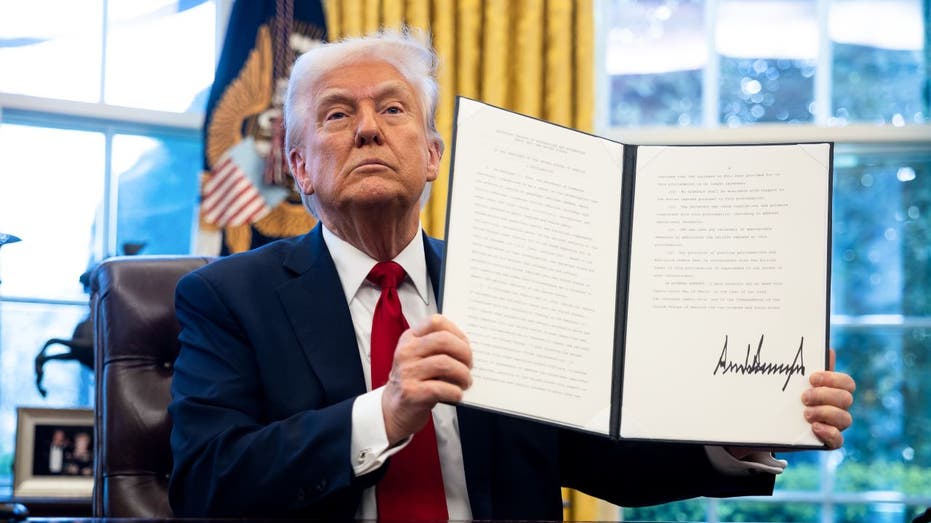The panelists of “The Claman Countdown” Jason Katz and Phil Camporeale analyze the economic movements of President Donald Trump.
President Donald Trump’s second presidential mandate has reached his 100 -day milestone after insulgation, and stock market performance is located as the second worst in the last 80 years.
The S&P 500 index decreased by 7.9% from the day of the inauguration until April 25, the end of the last week before the 100 -day brand, according to a CFRA analysis. In comparison, during Trump’s first mandate in 2016, the S&P 500 rose 5% in its first 100 days in office.
This decrease is the second largest decrease in the first 100 days of a presidential mandate, only following the fall of shares at the beginning of President Richard Nixon President Richard Nixon in 1972, when the S&P 500 fell by 9.9%.
Since 1944, seven presidential terms have begun with the S&P 500 decreasing by the first 100 days, while 14 presidential terms saw increases during those periods. Trump’s second mandate is the first presidential term to see market decrease during the first 100 days from the second term of President George W. Bush in 2004, when the S&P 500 fell 1.6%.
The first 100 days of President Trump in office: How is inflation?

The performance of the S&P 500 in the first 100 days of Trump’s second term is the second worst among administrations since World War II. (Francis Chung/Politic/Bloomberg through Getty Images)
The presidential administration under which the S&P 500 made the best was 1944, when Franklin D. Roosevelt, who died on April 12 of that year, and his successor, Harry Truman, were in office. S&P 500 increased 10.4% in that 100 -day period.
Other notable profits in the first 100 days of a presidential term occurred under John F. Kennedy (+8.9%), Joe Biden (+8.5%) and Barack Obama (+8.4%).
The only Republican president since World War II who saw a positive performance in the S&P 500 during his two presidential terms was Ronald Reagan, who saw profits of 0.9% and 5% in the first 100 days of his first and second terms, respectively.
Consumer confidence fell to a minimum of 5 years in April

Trump announced a “reciprocal” tariff policy based on bilateral commercial deficits as part of his announcement of “Day of Liberation” in the White House Garden. (Somodevilla/Getty images)
The CFRA report said that “investors are more concerned with the next 100 days and if the results for the first or next 100 days were predictive of the yields of the whole year.”
“Again from World War II, the S&P 500 increased an average of 3.2% for the next 100 days and 65% of the time was higher,” wrote the Cfra Sam Stovall head of investment strategist. He pointed out that “a return above the average in the first 100 days resulted in an average gain of the whole year of 21.1%”, but that, on the contrary, a “first 100 days below the average saw a decrease in the entire year of 5.5%.”
During the next 100 days, a decrease above average resulted in a gain of 22% throughout the year, while a yield below the average saw an average decrease of 3.7%, he added.
Price increases induced by the rate, commercial concerns highlighted in the Fed Beige book

The Trump administration is negotiating trade agreements with multiple commercial partners. (Win McNamee/Getty Images)
Financial markets have experienced high levels of volatility in the midst of Trump’s efforts to restore global commercial flows to more favorable terms for the US. UU. By imposing radical rates on commercial partners.
The uncertainty about the duration of tariffs and the potential of greater escalation, as well as the possibility that the interruption would cause a recession, has continued to weigh in the markets as the administration begins negotiations with other countries.
In his speech to a joint session of Congress in early March, Trump said that the interruption caused by his tariffs will be worth the long -term US economy.
Get the Fox business on the fly by clicking here
“Tariffs are about making the United States back to rich and making the United States be great. And it is happening, and it will happen quite fast,” Trump said. “There will be some disturbance, but we agree with that. It will not be much.”


